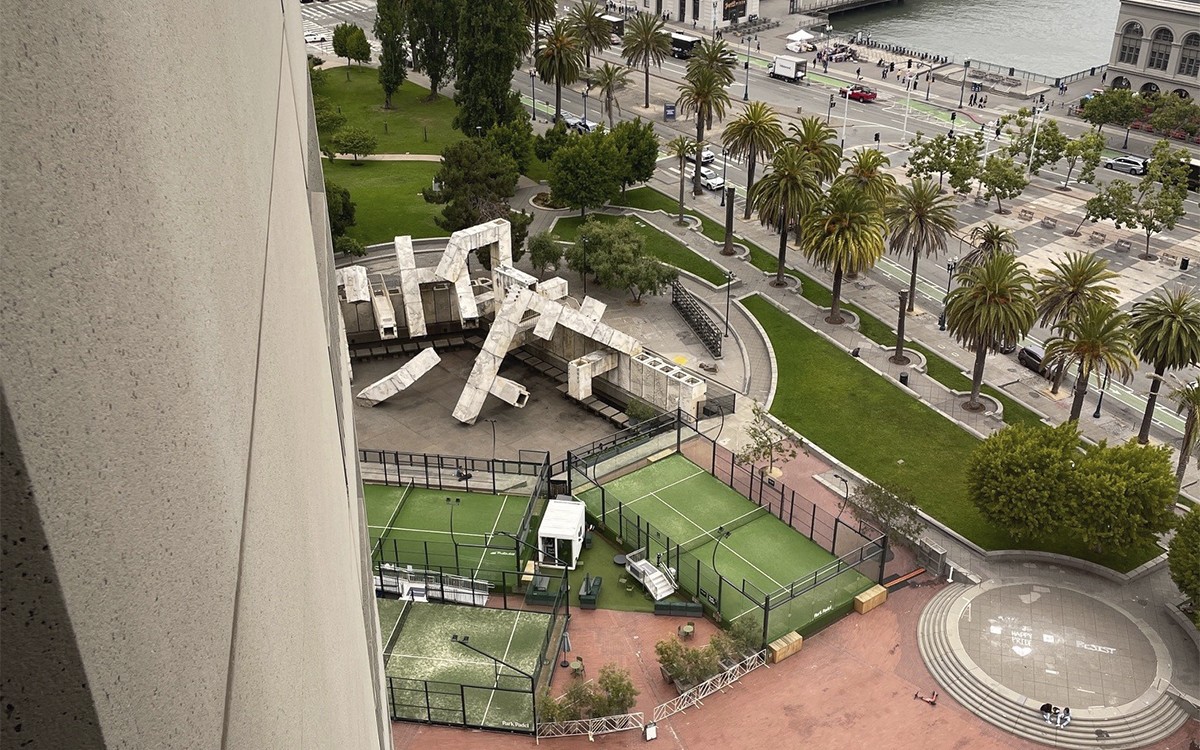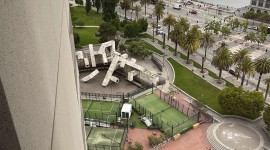Mismanaged efforts to demolish the Vaillancourt Fountain take a new turn
In a surprise announcement on Friday, October 31, 2025, the public learned that the San Francisco Recreation and Park Department (RPD) had suddenly determined that the Vaillancourt Fountain at Embarcadero Plaza posed “an immediate and serious hazard” and that the San Francisco Arts Commission (SFAC), which owns the fountain, was being asked to vote at their next meeting on Monday, November 3, to disassemble the work and ship it off to storage. RPD and BXP (formerly Boston Properties), which is the largest commercial landlord in the city and owns Embarcadero Center next to the plaza, are actively campaigning to redesign the plaza and fountain and redevelop the site, and RPD has been trying to get the SFAC to “deaccession” the fountain from the Civic Art Collection, which would facilitate its demolition. RPD claims the cost to rehabilitate the artwork is a budget buster, so they’ll spend $2.5 million to demolish it However, it seems SFAC wasn’t acting fast enough for RPD, so parks spokespeople have deployed their latest strategy and newest talking point.
In a San Francisco Chronicle exclusive by veteran reporter Sam Whiting, RPD spokesperson Tamara Aparton told Whiting the disassembly and storage, which would cost $4.4 million, nearly $2 million more than demolition, “is solely for public safety reasons, after two reports have stated that the fountain poses an immediate and serious hazard.” The timing is significant because two days earlier a Historic Resources Review prepared by the city’s own Planning department was released and it had determined that the artwork was eligible for listing in the National Register of Historic Places, which offered it some protection under the California Environmental Quality Act (CEQA). The determination affirmed the findings of the earlier city-commissioned study by consulting firm Page & Turnbull’s 122-page Vaillancourt Fountain Conditions Assessment, dated June 2, 2025.
So, what accounts for this near “hair on fire” urgency in RPD’s messaging?

The Cultural Landscape Foundation (TCLF) asked Eoanna Goodwin, the RPD Project Manager in charge of the proposed redevelopment of Embarcadero Plaza and the Vaillancourt Fountain: Which two reports referred to the fountain as posing an “immediate hazard”? Goodwin replied: “She is referring to the letter attached and the Structural Observation and Evaluation by DCI Engineers from the Conditions Assessment which I believe you already have.”
The “letter attached” is from Patrick O’Riordan, Director of the city’s Department of Building Inspection (DBI), and dated October 27, 2025. The DCI Engineers fifteen-page report dated May 19, 2025, was prepared for Page & Turnbull and appears in the latter’s Vaillancourt Fountain Conditions Assessment.
TCLF found that neither document stated the fountain was an “immediate” hazard. Again, these are the documents that Goodwin says are the basis for RPD spokesperson Aparton’s claim of “immediate” hazard.
The letter from DBI Director O’Riordan states, in part:
On October 15, 2025, Department of Building Inspection (DBI) engineering and inspection staff observed the existing condition of the Vaillancourt Fountain to be generally consistent with DCI Engineers' observations in the report. Specifically, DBI staff confirmed that visible material features of Vaillancourt Fountain display corrosion and degradation.
Based on the DCI report and staff inspection, DBI confirms the Vaillancourt Fountain site should remain vacated and secured from public access until the hazardous conditions are abated. DBI advises following the recommendations outlined in the DCI report and strengthening the existing security measures until remedial work can be completed.
The DBI report affirms the current situation, that “the Vaillancourt Fountain site should remain vacated and secured from public access until the hazardous conditions [corrosion and degradation] are abated.”
Similarly, the DCI Engineers report has no language about the fountain being an “immediate” hazard. Their report does confirm that the fountain has “significant corrosion and damage ... to the precast concrete tubes and steel components that make up the Vaillancourt Fountain in San Francisco. This deterioration is the result of spalling of the concrete, which has exposed the steel anchor plates and reinforcing to the marine atmosphere.”
Again, an examination of the documents shows that neither stated the fountain was an “immediate” hazard. Nevertheless, RPD obtained a letter from the city’s Planning department exempting the fountain from CEQA thus allowing the work to be disassembled “to eliminate an immediate public threat.” The letter relies on the same two “reports” Aparton cited above that say nothing about “immediate” hazard, but it also cites a third document that states “A detailed project description prepared by SFRPD (Attachment A) outlines the need for urgent project implementation ... to eliminate an immediate public health risk.” That Attachment A “Project description submitted by SFRPD on October 30, 2025” to the Planning department did not appear among the documents released by the Arts Commission on October 31, but it was posted by the morning of November 3.

First, the document has a great deal of language concluding the fountain poses a significant safety risk, but it is unsigned so we do not know who came to this conclusion. It only says “RPD has concluded” and variants of that phrase. Second, the attachments cited at the end of the document, noted above, do not conclude the artwork is an immediate hazard or words to that effect. They describe the current state of the fountain. So, who at RPD, and with what qualifications, looked at all of those documents—none of which say the fountain is an immediate hazard—and came to the opposite conclusion and wrote that the work is an imminent public safety risk?
It also includes this statement:
“DBI has reviewed the Conditions Assessment and concurs with the finding that the fountain, in its current state, constitutes a public safety hazard.” [emphasis added]
The statement by the Department of Building Inspector, posted and hotlinked above, does not include the language “public safety hazard.” It addresses “hazardous conditions,” which follows the sentence that states: "Specifically, DBI staff confirmed that visible material features of Vaillancourt Fountain display corrosion and degradation.”
There is no declaration/conclusion about a "public safety hazard."
Keep in mind that Aparton and others at RPD, including its General Manager, Phil Ginsburg, have made another specious claim that was repeated frequently including in a written statement to the SFAC.
A May 25, 2025, SFGate article quotes Aparton as saying: “On average, the cost to maintain the fountain was $100,000 per year ... also “reflecting thousands of labor hours over the years.” RPD Director Phil Ginsburg made the same claim in writing to the SFAC.
TCLF FOIA’ed RPD for documents to support their claims. The response RPD sent to TCLF showed that:
1. RPD had inflated the average annual budget by 250%
2. The supposed “tens of thousands of cumulative labor hours” was actually 1,578.
Even if these numbers are “to be taken with a grain of salt,” as RPD’s Director of Operations Eric Andersen cautioned in a memo accompanying the estimates, they vastly exceed a rounding error.

To sum up the situation, RPD is determined to destroy the Vaillancourt Fountain, widely acknowledged as the most important work by the 96-year-old Canadian artist Armand Vaillancourt. Since early this year the RPD’s messaging has lurched from one spurious set of claims and talking points to another:
1. This year they claimed they didn’t want to demolish the fountain before they announced that they did. But as Taylor Noakes reported in the Art Newspaper, there’s been a bull’s-eye on the plaza and fountain for years. RPD’s Ginsburg said during an October 17, 2024, Recreation and Park Commission meeting that he started having conversations with developer BXP about redeveloping the plaza "eight to ten years ago”;
2. RPD claimed in October 2024 that rehabilitating the fountain would cost $3-10 million; by June 2025 it was $12-17 million, and more recently it ballooned to a still uncorroborated estimate of $29 million;
3. RPD overinflated what they claimed is their annual maintenance budget for the fountain by 250% and the "cumulative labor hours" by vastly more;
4. RPD claimed the fountain was an “immediate” hazard and cited as proof documents that said nothing of the sort.
Now RPD is about to get the SFAC to rubber stamp the “immediate” hazard claim by voting to permit the fountain to be disassembled and put into storage.
But don’t worry, as Aparton told the Chronicle, putting the fountain into storage “is a temporary measure that does not have anything to do with [its] ultimate fate.”
Sure ... we can take their word on that.






